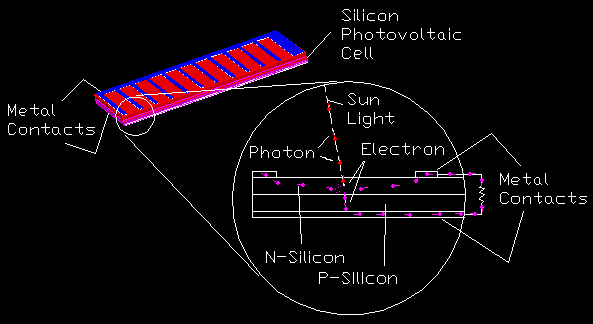
This is a battery? I came across
The Lemon Battery |
|
| What does a battery have to do with a solar cell? If you look at the schematic symbol (See below) for a battery it is the same as the schematic symbol for a solar cell except the little arrows show that the cell is light sensitive or light activated. You can use a solar cell like a battery and you can put them together just like a battery (in series) to increase the voltage and current output. See more below....... | |

How does a Solar Cell (Silicon Photovoltaic Cell) work...? The sketch above shows an edge view of the Solar Cell. Simply put, the light is composed of what are know as photons and these photons strike the electrons inside the N-Silicon. The N-Silicon has an excess of electrons and when enough photons hit enough electrons, the electrons are forced down into the P-Silicon, which has fewer electrons and when the P-Silicon side gets all those electrons knocked down to it, then electrons have a tendency to flow on the (+) contact. When a wire is connected between the (-) contacts and the (+) contacts then the N-Silicon gets replenished with more electrons, so a circuit is formed with Sunlight (photons) causing a flow of electrons.
 The battery is made up of
several different cells or plates connected together. A PV
cell is a single cell so it only has 1 plate.
The battery is made up of
several different cells or plates connected together. A PV
cell is a single cell so it only has 1 plate.
Remember the photons striking the N side of the cell above. The two arrows represents light and with electronic symbols the arrows could be pointing away. In the case of the cell, light effects the cell by creating electricity. If the arrows point away, then it means the cell would be giving off light.

Nice cell, it has pads on the back to solder too and it is completely environmentally sealed. This is important because the environment can degrade the cell rather quickly.
So now I have a solar panel to play with. What I have done is run a wire from each cell to the right, so that is what all the wires are. This will enable me to wire up the panel for whatever I want to do.
High Voltage Miniature Solar Cell, ideal to replace 9V batteries or equivalent loads. Can be combined in series or parallel arrangements for increased voltage or current. Ideal for use with motors or other solar products.
Technical Data
• Polycrystalline Solar Cell
• Efficiency: 14.7%
• Color: Black
• Peak Voltage (Vmp): 8.64V
• Open Circuit Voltage (Voc): 9.5V
• Peak Current (Imp): 70mA
• Short Circuit Current (Isc): 75mA
• Dimensions: 85mm x 69mm x 2.5mm (LxWxD)
Cost $6.90 (November 2008)
Because I am experimenting with solar cells I need to wire them up in such a way so I can experiment and get different voltages and different currents.
Discovered something interesting that I did not think of when I started experimenting with solar cells.
I was hooking a group of cells in series and when I got to about 100VDC my multimeter stopped giving me a readout on voltage. My first instinct was that the cells had a problem, and it turned out that my multimeter only goes up to 100VDC. This means that I now need to figure out how to read voltages greater that 100VDC with my meter... A new challenge....More later...
This is picture of the pigtails hanging off the edge of the 1/4 inch thick plywood panel. It has been reinforced by 1x2 to make it rigid and to enable me to attach to act as attachment points.
More later, come back to see....l
